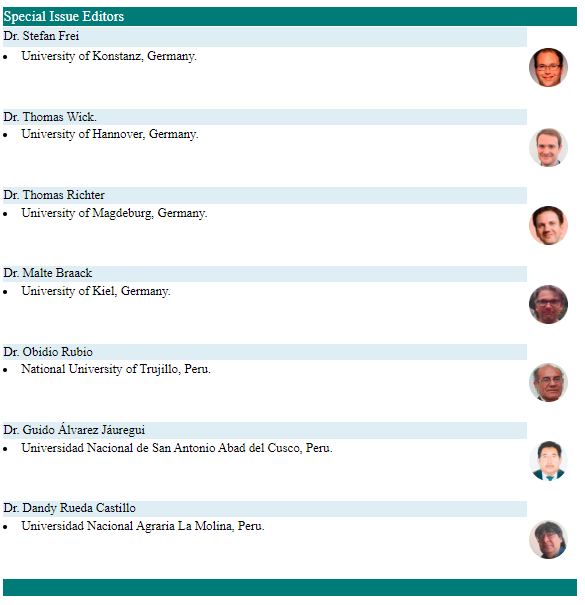Refuge used by prey as a function of predator numbers in a Leslie-type model
DOI:
https://doi.org/10.17268/sel.mat.2024.02.04Keywords:
Predator-prey model, refuge, stability, bifurcations, limit cycles, separatrix curvesAbstract
This paper deals with a continuous-time predator-prey model of Leslie-Gower type considering the use of a physical refuge by a fraction of the prey population. The fraction of hidden prey is assumed to be dependent on the presence of predators in the environment.
The conditions for the existence of equilibrium points and their local stability are established. In particular, it is shown that the point (0; 0) has a great importance in the dynamics of the model, since it determines a separating curve Σ that divides the behavior of the trajectories.
Those trajectories that are above this curve have as their w- limit the point (0; 0), so the extinction of both populations may be possible depending on the initial conditions.
References
Bacaër N. A short history of Mathematical Population Dynamics, Springer-Verlag ,2011.
Volterra V. Variazioni e fluttuazioni del numero d’individui in specie animali conviventi, Memorie della R. Accademia dei Lincei, S.VI, IT 1926; II: 31-113.
Gause GF. The Struggle for existence, Dover, 1934.
Leslie PH. Some further notes on the use of matrices in population mathematics, Biometrica 35 (1948), 213-245.
Leslie PH, Gower JC. The properties of a stochastic model for the predator-prey type of interaction between two species, Biometrika 47 (1960), 219-234.
May RM. Stability and complexity in model ecosystems, (2nd edition) Princeton University Press, 2001.
Turchin P. Complex population dynamics. A theoretical/empirical synthesis, Monographs in Population Biology 35 Princeton University Press, 2003.
Freedman HI. Deterministic Mathematical Model in Population Ecology, Marcel Dekker (1980).
Bazykin AD. Nonlinear Dynamics of interacting populations, World Scientific Publishing Co. Pte. Ltd., 1998.
Korobeinikov A. A Lyapunov function for Leslie-Gower predator-prey models. Applied Mathematics Letters 14 (2001), 697-699.
Almanza-Vásquez E. González-Olivares E, González-Yañez B, Dynamics of Lotka-Volterra model considering satured refuge for prey, In R. Mondaini (Ed.) BIOMAT 2011 International Symposium on Mathematical and Computational Biology, World Scientific Co. Pte. Ltd. (2012), 62-72.
González-Olivares E, Ramos-Jiliberto R. Consequences of prey refuge use on the dynamics of some simple predator-prey models: Enhancing stability?, In R. Mondaini (ed.), Proceedings of the Third Brazilian Symposium on Mathematical and Computational Biology (BIOMAT-2003), E-Papers Servic¸os Editoriais Ltda., Rio de Janeiro, Volumen 2 (2004), 75-98.
Chen L, Chen F, Chen L On a Leslie-Gower predator prey model incorporating a prey refuge. Nonlinear Analysis Real World & Applications10 (2009), 2905-2908.
González-Olivares E, Gonzalez-Yañez B, Becerra-Klix R, Multiple stable states in a model based on predator-induced defenses, Ecological Complexity 32 (2017), 111-120.
González-Olivares E, Rojas-Palma A, López-Cruz R. Influencia del uso de refugios por las presas en el modelo de depredación de Volterra (Influence of the prey refuge on the Volterra predation model), Selecciones Matemáticas 11(1) (2024), 56-68.
Maynard Smith J. Models in Ecology, University Press, (1974).
González-Olivares E, Ramos-Jiliberto R. Dynamic consequences of prey refuges in a simple model system: more prey, fewer predators and enhanced stability, Ecological Modelling 166 (2003), 135-146.
González-Olivares E, Ramos-Jiliberto R. Comments to "The effect of prey refuge in a simple predatorprey model" [Ecol. Model. 222 (September(18)) (2011) 3453-3454], Ecological Modelling 232 (2012), 158-160.
Goh B-S. Management and Analysis of Biological Populations, Elsevier Scientific Publishing Company, 1980.
Chicone C. Ordinary Differential Equations with Applications. Texts in Applied Mathematics. Springer, New York, 2008.
Dumortier F, Llibre J, Artés JC. Qualitative theory of planar differential systems, Springer, Berlin, Heidelberg, 2006.
Murray JD. Mathematical Biology, Springer - Verlag New-York, 1989.
Clark CW. Mathematical Bioeconomic. The optimal management of renewable resources, John Wiley and Sons, 1990.
Taylor RJ. Predation. Chapman and Hall, 1984.
Berryman AA, Gutierrez AP, Arditi R. Credible, parsimonious and useful predator-prey models-A reply to Abrams, Gleeson and Sarnelle, Ecology 76 (1995), 1980-1985.
Downloads
Published
How to Cite
Issue
Section
License

This work is licensed under a Creative Commons Attribution 4.0 International License.
The authors who publish in this journal accept the following conditions:
1. The authors retain the copyright and assign to the journal the right of the first publication, with the work registered with the Creative Commons Attribution License,Atribución 4.0 Internacional (CC BY 4.0) which allows third parties to use what is published whenever they mention the authorship of the work And to the first publication in this magazine.
2. Authors may make other independent and additional contractual arrangements for non-exclusive distribution of the version of the article published in this journal (eg, include it in an institutional repository or publish it in a book) provided they clearly state that The paper was first published in this journal.
3. Authors are encouraged to publish their work on the Internet (for example, on institutional or personal pages) before and during the review and publication process, as it can lead to productive exchanges and to a greater and more rapid dissemination Of the published work.












